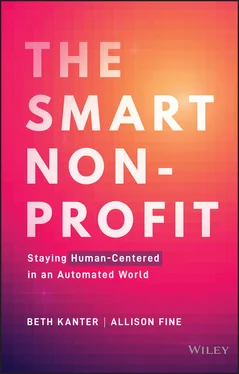Integrating smart tech into organizational functions could create an enormous return on investment that will allow for:
More time with clients: Instead of spending time checking off lists and filling out forms, case workers will spend more time with clients to understand the origins of their problems, the obstacles that get in the way of their success, and providing real-time support when life gets really hard.
Crisis prevention and reduction: Smart tech can help identify people at risk of becoming homeless before crises overwhelm them. For instance, the city of London, Ontario, uses a new smart tech system to track people at risk of becoming chronically homeless (with their permission) to prioritize services for them before a crisis. 7 Smart tech will help forecast environmental disasters earlier and help with rescue operations. Resources will be directed to victims faster.
Deeper and more meaningful relationships with donors: Transactional fundraising, treating every donor like an ATM machine, has become the norm for too many organizations. Smart tech frees staff from updating donor bases and researching prospects to spending time getting to know donors in meaningful ways: learning more about their interests and the reasons your cause is important to them and turning these donors into ambassadors to recruit and nurture donors within their personal networks.
Reduced astroturfing: Advocacy organizations too often substitute marketing efforts for real grassroots organizing. For instance, the use of online petitions that is actually used to capture email addresses for future communications. Instead of “astroturfing” support for climate change, advocates could use the dividend of time to engage with supporters and get to know them, educate them on the issue, and teach them how to become advocates and create their own group of supporters.
More time to think: People and organizations are so busy doing the work, and the work to support the work, that there is very little time for reflection on how the work is done and how to improve it. Imagine having time to consider other ways to do intake with clients rather than furiously responding to a barrage of inquiries every day? Imagine having time to talk to supporters about what kind of support they would need to gather their friends and help them become ambassadors? Imagine having time to just think.
A REAL-WORLD SMART NONPROFIT
TalkingPoints is a great example of a smart nonprofit.
Heejae Lim, founder of TalkingPoints, didn't need to do any research about the difficulty immigrant parents have navigating school systems; she lived it as the child of immigrants. Her family moved from Korea to London when she was eight. Heejae had an advantage that many of her immigrant friends didn't: her mother spoke English well. Heejae's mother was a fierce advocate for her at school. She also translated for the parents of her friends. 8
Following business school at Stanford University, Heejae decided to do what she does best: address a difficult problem using her advanced technology know-how. She founded TalkingPoints as a nonprofit to translate messages between teachers and parents.
About a quarter of all school children in the United States speak a language other than English at home. These are families where parents often work multiple jobs, may come from cultures where parents are not supposed to engage with teachers, and most importantly, do not speak English well enough to feel comfortable speaking to teachers.
Family engagement with schools is not a minor issue when it comes to educational outcomes. It is twice as effective in predicting school success than socioeconomic status. Let that sink in for a second: for school success matters much less whether a child is from a high-income home than whether adults in a child's life talk to their teachers. However, family-school engagement occurs up to 50% less among families in under-resourced, multilingual communities. 9
TalkingPoints’ app works like text messaging on mobile devices. It operates in over 100 languages, provides closed captioning for video messages for parents who may not be comfortable writing, and enables parents and guardians to engage with teachers during the cracks of their very busy days.
TalkingPoints started with a simple proof of concept and a small group of families. Using a Google spreadsheet, a text messaging app, and human translators, Heejae and her team simulated an automated process from end to end. Here's how it worked. A parent sent a text message in their native language. Heejae added it to the spreadsheet. Next, a human translator translated the message into English. Heejae texted the translated message to the teacher or administrator. And back and forth they went. Heejae told us, “We always start with a proof of concept with a small group before we build, as part of doing no harm.”
The team learned a lot from this early testing and automated and launched the pilot version in 2015 with 100 families. Most importantly, they learned they couldn't rely on off-the-shelf translation tools alone because these tools often misinterpreted context and cultural norms. The volunteer translators review the machine translation to ensure cultural accuracy and that educational terms are accurately translated. These translations are being fed back into the model to continuously improve it. The aim is to build a large and deep enough database of translations to direct only the difficult-to-understand conversations to human translators.
TalkingPoints meets our definition of smart nonprofits: organizations that are human-centered, prepared, and knowledgeable and reflective. People are deeply engaged in the process, and the team designed and are implementing the app carefully and thoughtfully; they have done their homework about cultural competence, education, and the needs of immigrant families; the staff includes people with experts in education and tech; and everyone has experience working with immigrant families and schools.
The results show the effectiveness of working this way.
By 2019, the app facilitated over 20 million conversations for 500,000 parents and teachers. TalkingPoints is also free for users. An outside research firm was engaged to evaluate the effort. It found that:
89% of the schools using the app serve low-income children.
97% of teachers have found TalkingPoints helpful in meeting their family engagement goals.
98% of teachers were able to reach families they had never reached before.
83% of teachers believe that they are more informed about students’ needs because of their relationships with families. 10
VI-SPDAT blocked access to services. TalkingPoints creates access for a woefully underserved population. These cases highlight why it is so important for organizations to step carefully into the use of smart tech.
THE DANGERS OF AUTOMATION
Nicholas Carr wrote in The Glass Cage , “Automation severs ends from means. It makes getting what we want easier, but it distances us from the work of knowing.” 11
There is enormous danger and damage to be done in distancing ourselves from knowing. It means potentially cutting ourselves off from the needs of clients if they are first interacting with bots screening them for services. It could mean using automation to send out many times more fundraising appeals and not listening to the complaints from current and prospective donors. It could mean hiding behind screens instead of stepping out to build stronger relationships with constituents. And it could mean allowing an insidious form of racism and sexism to take hold unabated inside your organization.
We tend to see work done by computers and robots as incapable of being swayed by emotions and therefore incapable of being racist, sexist, or otherwise biased or unfair. However, the code that powers smart tech was at some point created by people and carries forward their opinions, assumptions, and biases. When this code makes decisions that are discriminatory, we call it embedded bias . The renowned data scientist Cathy O'Neil says, “Algorithms are opinions embedded in code.” 12
Читать дальше












